The evolution of technology is a fascinating journey, marked by pivotal moments and groundbreaking innovations. Understanding the history of Blockchain Projects is crucial to appreciating its current impact and predicting its future. From humble beginnings, these early digital pioneers laid the foundation for a transformative technology that’s reshaping industries worldwide.
1. Remembering the Pioneers: Early Blockchain Projects That Shaped the Industry
1.1 Bitcoin: The Genesis of Blockchain Technology
Bitcoin, launched in 2009 by the pseudonymous Satoshi Nakamoto, wasn’t just a new cryptocurrency; it was the first practical implementation of blockchain technology. Its decentralized nature, secured by cryptography and distributed across a network of computers, solved the “double-spending” problem that had plagued previous digital currencies. This breakthrough, documented in the Bitcoin whitepaper, marked the genesis of a technological revolution. The impact was immediate, demonstrating the potential of a truly decentralized and transparent system. It wasn’t just about money; it was about a new way of thinking about trust and transactions.
Bitcoin’s success wasn’t immediate. Early adoption was slow, and the technology was largely unknown outside of tech circles. However, its underlying principles—cryptographic security, distributed ledger technology, and consensus mechanisms—laid the foundation for countless subsequent blockchain projects.
1.2 Ethereum: Enabling Smart Contracts and Decentralized Applications
Ethereum, launched in 2015, expanded the capabilities of blockchain far beyond simple transactions. It introduced the concept of smart contracts—self-executing contracts with the terms of the agreement directly written into code. This innovation opened up a world of possibilities, enabling the creation of decentralized applications (dApps) that operate autonomously and transparently. Ethereum’s programmable blockchain provided a platform for developers to build a wide range of applications, from decentralized finance (DeFi) protocols to supply chain management systems.
Unlike Bitcoin’s focus on a single currency, Ethereum’s architecture provided a flexible framework for a vast ecosystem of decentralized applications, effectively transforming blockchain from a transactional tool into a platform for innovation. This significant advancement marked a turning point in the development of blockchain technology, showing its versatility beyond simple digital currency.
1.3 Ripple: Facilitating Cross-Border Payments
Ripple, established in 2011, focused on solving a different problem: the inefficiencies of cross-border payments. Traditional international transfers are often slow, expensive, and opaque. Ripple’s blockchain technology offered a faster, cheaper, and more transparent alternative, facilitating near-instantaneous transactions across borders. Its solution, known as XRP, aimed to streamline the process by providing a bridge between different currencies and financial institutions.
While facing regulatory scrutiny and evolving market dynamics, Ripple’s innovative approach highlighted blockchain’s potential in disrupting the established financial infrastructure. This demonstrated the applicability of blockchain beyond cryptocurrency, showcasing its transformative power within existing financial systems. Ripple’s journey exemplifies the challenges and opportunities of navigating regulatory landscapes while pioneering technological advancements.
1.4 Litecoin: A Faster and More Efficient Alternative to Bitcoin
Litecoin, launched in 2011, aimed to improve upon Bitcoin’s limitations by offering faster transaction times and a different mining algorithm. It presented itself as a more efficient and scalable alternative, addressing some of the early criticisms of Bitcoin’s performance. While not achieving the same level of market dominance as Bitcoin, Litecoin’s contribution to the early blockchain ecosystem was significant, demonstrating the potential for variation and improvement within blockchain architectures. It highlighted the iterative nature of technological development in the blockchain space, showcasing how different projects can address specific needs and limitations.
Litecoin’s success showed that the principles of blockchain were adaptable and could be implemented in different ways to optimize performance and address specific use cases. This paved the way for numerous altcoins and further innovation in the blockchain space. Its existence underscored the growing understanding of blockchain’s potential beyond a single dominant application.
2. The Impact of Early Blockchain Projects
2.1 Revolutionizing Finance and Payments
The impact of early blockchain projects on finance and payments is undeniable. Bitcoin demonstrated the potential for a decentralized, peer-to-peer payment system, eliminating the need for intermediaries. Ethereum’s smart contracts enabled the creation of decentralized finance (DeFi) platforms, offering innovative financial products and services. Ripple aimed to streamline cross-border payments, reducing costs and transaction times. These early projects demonstrated blockchain’s capacity to transform the existing financial infrastructure, challenging traditional systems and promoting greater efficiency and transparency.
This disruption is ongoing, with decentralized exchanges (DEXs), stablecoins, and other DeFi innovations constantly emerging. The blockchain projects’ early success in this area signaled a fundamental shift in how we think about finance and transactions. The pioneering efforts laid the groundwork for a more accessible, inclusive, and efficient financial system.
2.2 Empowering Decentralized Applications
Beyond finance, early blockchain projects paved the way for a new generation of decentralized applications (dApps). Ethereum’s smart contract functionality unlocked a wide range of possibilities, enabling the creation of dApps across various sectors, including gaming, supply chain management, and digital identity. These applications leverage the inherent security, transparency, and immutability of blockchain to create trustless and efficient systems.
The development of dApps is still in its early stages, but the potential for disruption is immense. The early pioneers demonstrated the possibility of building applications that are not controlled by a single entity, offering greater user control and data privacy. This trend promises to reshape various industries and empower users in unprecedented ways.
2.3 Sparking Innovation and Entrepreneurship
The early success of blockchain projects has sparked a wave of innovation and entrepreneurship. The technology’s open-source nature and decentralized ethos have fostered a vibrant community of developers, entrepreneurs, and investors. This collaborative environment has led to a rapid pace of innovation, with new projects and applications constantly emerging.
The open-source nature and decentralized governance models adopted by early blockchain projects encouraged community involvement and collaboration, thereby fueling rapid innovation and the birth of a dynamic entrepreneurial ecosystem. This decentralized approach has facilitated the development of a wealth of new applications and ideas, transforming the landscape of technology.
3. Lessons Learned from the Pioneers
3.1 The Importance of Community and Collaboration
The success of early blockchain projects highlights the critical role of community and collaboration. Open-source development, community governance, and active participation from developers and users have been instrumental in the growth and evolution of blockchain technology. This collaborative ethos is essential for the continued development and adoption of blockchain solutions.
This collaborative spirit fostered a robust environment for identifying and resolving bugs, optimizing functionalities, and introducing novel approaches. The collective effort resulted in a more secure and efficient system, showcasing the benefits of open-source principles in software development.
3.2 The Need for Scalability and Security
Early blockchain projects also underscored the importance of scalability and security. Bitcoin’s limitations in transaction speed and scalability have led to the development of alternative solutions, such as Litecoin and other layer-2 scaling protocols. Security remains paramount, with ongoing efforts to enhance the robustness and resilience of blockchain networks against attacks.
Addressing scalability and security concerns is crucial for the widespread adoption of blockchain technology. These early lessons have driven significant advancements in consensus mechanisms, transaction processing, and cryptographic techniques, resulting in more efficient and secure systems. Continuous development is key to maintaining a secure and scalable blockchain infrastructure.
3.3 The Evolution of Blockchain Technology
Early blockchain projects laid the groundwork for the evolution of the technology. The lessons learned from the pioneers have led to the development of improved consensus mechanisms, more efficient transaction processing, and advanced cryptographic techniques. Blockchain technology is constantly evolving, with new innovations and applications emerging.
This continuous development is a testament to the dynamic nature of the blockchain space and showcases its potential for ongoing improvement. The lessons learned from early projects have enabled the creation of more scalable, secure, and efficient blockchain solutions, demonstrating the transformative potential of continuous innovation.
4. The Future of Blockchain
4.1 Emerging Trends and Innovations
The future of blockchain is bright, with emerging trends and innovations constantly pushing the boundaries of the technology. We are seeing advancements in areas such as layer-2 scaling solutions, decentralized identity, and the integration of blockchain with other technologies like artificial intelligence and the Internet of Things (IoT). These innovations promise to unlock even greater potential for blockchain across various industries.
These advancements promise to address some of the current limitations of blockchain technology, enabling greater scalability, efficiency, and interoperability. The convergence of blockchain with other technologies is expected to generate significant innovation across diverse sectors.
4.2 The Potential for Disruption Across Industries
Blockchain technology has the potential to disrupt various industries, from finance and supply chain management to healthcare and voting systems. Its ability to create transparent, secure, and efficient systems is transforming how organizations operate and interact with their stakeholders. The ongoing development and adoption of blockchain will continue to reshape the landscape of numerous industries.
The transformative power of blockchain spans various sectors, offering solutions to long-standing challenges in areas such as data management, traceability, and security. Its potential for streamlining processes and improving efficiency is driving its widespread adoption.
4.3 The Importance of Responsible Development and Adoption
As blockchain technology continues to evolve and mature, responsible development and adoption are crucial. Addressing ethical considerations, regulatory frameworks, and sustainability concerns is essential to ensure the technology’s positive impact on society. A collaborative effort from developers, policymakers, and users is necessary to guide the responsible development and adoption of blockchain.
Sustainable development and responsible governance are essential to maximizing the benefits of blockchain while mitigating any potential risks. This collective responsibility will ensure that blockchain technology is used ethically and for the betterment of society. The future of blockchain hinges on a commitment to responsible innovation and deployment.




